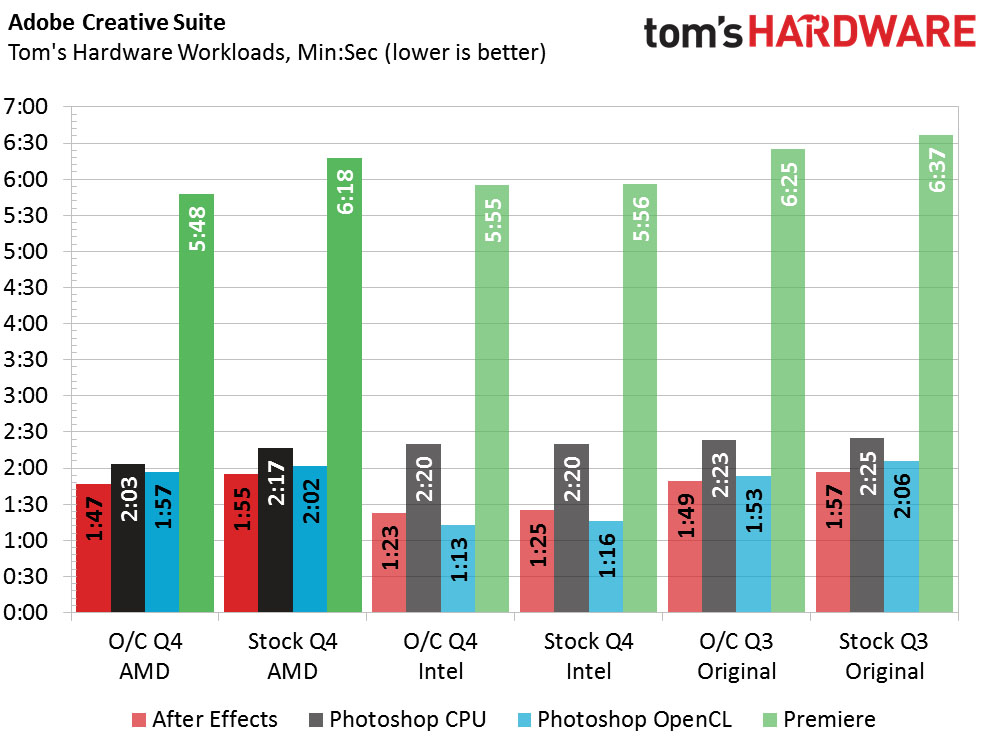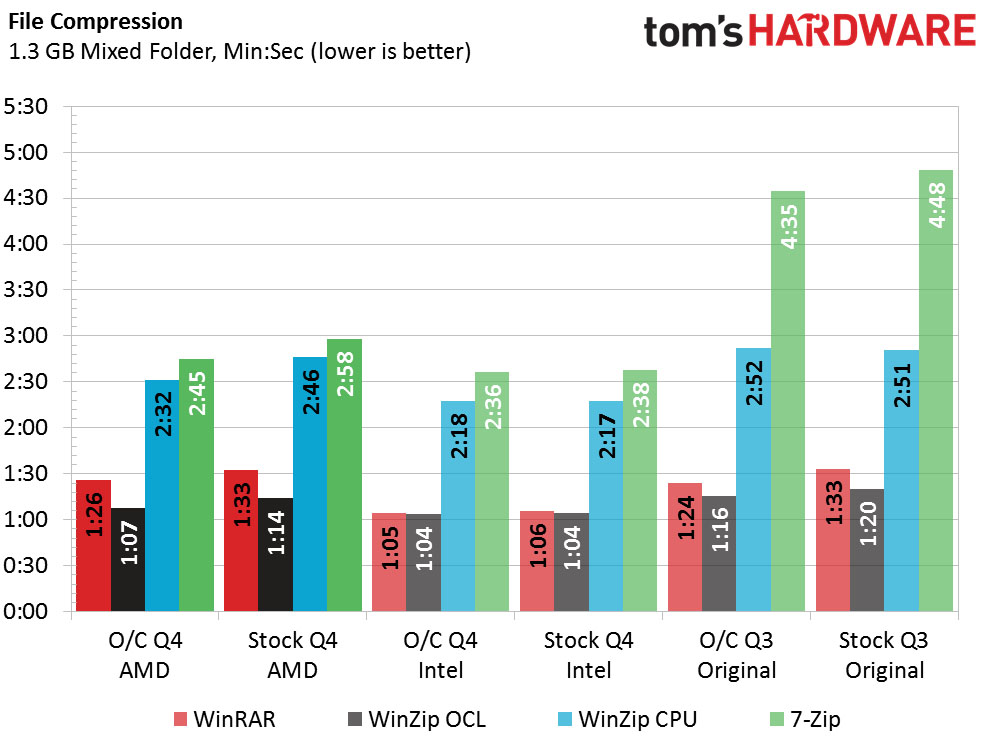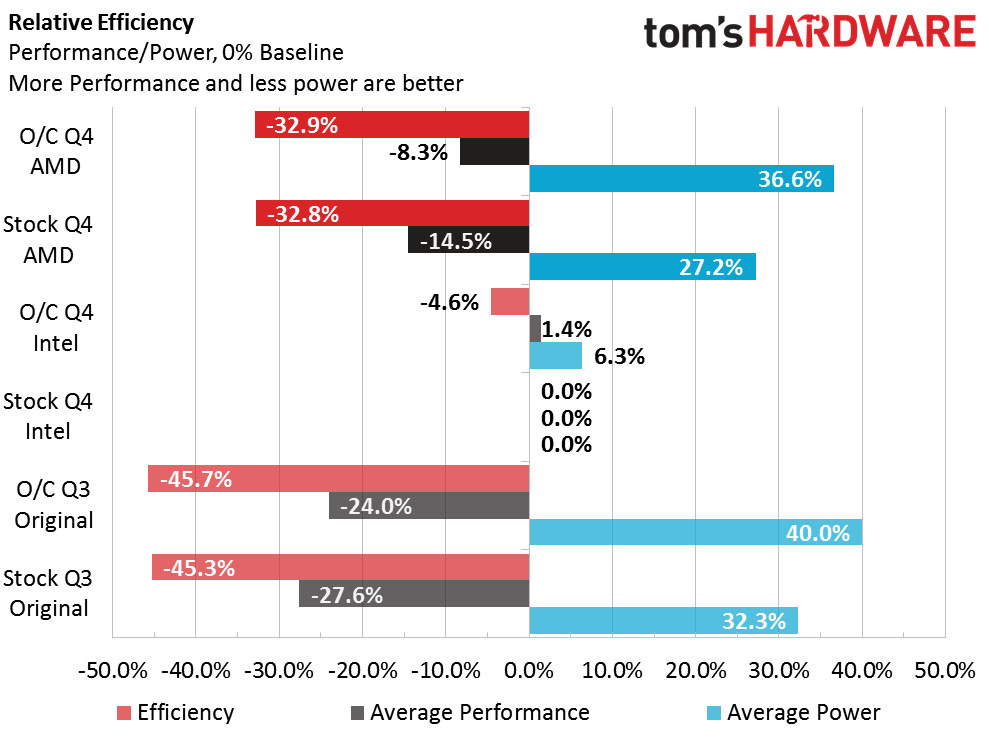System Builder Marathon Q4 2015: $912 AMD LAN Box PC
My Intel Revision Munchkin blew the original Q3 build out of the water. Can a properly cooled and overclocked Athlon 860K really match a Core i3?
Results
How We Test
I compare all three variations of the Munchkin in the following benchmark graphs. The stock Intel numbers from earlier this week are used as the 100 percent baseline that everything else will compared to. The main question today is if an 860K can be overclocked to match or beat an i3-4170, if not in actual performance, then at least in performance value. However, the latter is somewhat a moot point since this build is $14 more expensive than the Intel build.
| Test Hardware Configurations | |||
|---|---|---|---|
| Row 0 - Cell 0 | Q3 2015 $800 Munchkin | Q4 2015 Munchkin 2.0 | Q3 2015 $800 Munchkin |
| Processor (Overclock) | AMD Athlon X4 860K: 3.7 GHz, Four Cores O/C to | Intel i3-4170: 3.7 GHz, Dual-Core with Hyper-Threading | AMD Athlon X4 860K: 3.7 GHz, Four Cores O/C to 4.0-4.3GHz, 1.4V |
| Graphics (Overclock) | Asus GeForce GTX 970: 1228MHz GPU, GDDR5-7010 O/C to | Asus GeForce GTX 970: 1228MHz GPU, GDDR5-7010 O/C to | Asus GeForce GTX 970: 1228MHz GPU, GDDR5-7010 |
| Memory (Overclock) | 8GB Crucial DDR3-1600 CAS 9-9-9-24, O/C to | 8GB Crucial DDR3-1600 CAS 9-9-9-24, O/C to | 8GB Crucial DDR3-1600 CAS 9-9-9-24, |
| Motherboard (Overclock) | ASRock FM2A88X-ITX+ AMD A88X Bolton D4 100 MHz BCLK, | ASRock H97M-ITX/ac Intel H97 100 MHz BCLK | ASRock FM2A88X-ITX+ AMD A88X Bolton D4 100 MHz BCLK, |
| Case | Thermaltake Core V1 | Thermaltake Core V1 | Cooler Master Elite 130 |
| CPU Cooler | Deepcool Gamer Storm Gabriel 120mm | Stock | Stock |
| Hard Drive | Samsung 850 Evo 250GB 2.5" SSD | Samsung 850 Evo 250GB 2.5" SSD | WD Blue 1TB 7200rpm 3.5" HDD |
| Power | Seasonic M12II EVO 620W | Seasonic M12II EVO 620W | Corsair CX500M 500W |
| Software | |||
| OS | Microsoft Windows 8 Pro x64 | Microsoft Windows 8 Pro x64 | Microsoft Windows 8 Pro x64 |
| Graphics | Nvidia GeForce 359.06 | Nvidia GeForce 359.06 | Nvidia GeForce 355.60 |
| Chipset | AMD Catalyst All-in-1 v14.502.1013 | Intel INF 10.0.0.27 | AMD Catalyst All-in-1 v14.502.1013 |
Benchmark Suite
| 3D Games | |
|---|---|
| Battlefield 4 | Version 1.0.0.1, DirectX 11, 100-sec. Fraps "Tashgar" Test Set 1: Medium Quality Preset, No AA, 4X AF, SSAO Test Set 2: Ultra Quality Preset, 4X MSAA, 16X AF, HBAO |
| Grid 2 | Version 1.0.85.8679, Direct X 11, Built-in Benchmark Test Set 1: High Quality, No AA Test Set 2: Ultra Quality, 8x MSAA |
| Arma 3 | Version 1.08.113494, 30-Sec. Fraps "Infantry Showcase" Test Set 1: Standard Preset, No AA, Standard AF Test Set 2: Ultra Preset, 8x FSAA, Ultra AF |
| Far Cry 3 | V. 1.05, DirectX 11, 50-sec. Fraps "Amanaki Outpost" Test Set 1: High Quality, No AA, Standard ATC, SSAO Test Set 2: Ultra Quality, 4x MSAA, Enhanced ATC, HDAO |
| Adobe Creative Suite | |
| Adobe After Effects CC | Version 12.0.0.404: Create Video which includes 3 Streams, 210 Frames, Render Multiple Frames Simultaneosly |
| Adobe Photoshop CC | Version 14.0 x64: Filter 15.7MB TIF Image: Radial Blur, Shape Blur, Median, Polar Coordinates |
| Adobe Premeire Pro CC | Version 7.0.0 (342), 6.61 GB MXF Project to H.264 to H.264 Blu-ray, Output 1920x1080, Maximum Quality |
| Audio/Video Encoding | |
| iTunes | Version 11.0.4.4 x64: Audio CD (Terminator II SE), 53 minutes, default AAC format |
| Lame MP3 | Version 3.98.3: Audio CD "Terminator II SE", 53 min, convert WAV to MP3 audio format, Command: -b 160 --nores (160 kb/s) |
| Handbrake CLI | Version: 0.99: Video from Canon Eos 7D (1920x1080, 25 FPS) 1 Minutes 22 Seconds Audio: PCM-S16, 48000 Hz, 2-Channel, to Video: AVC1 Audio: AAC (High Profile) |
| TotalCodeStudio 2.5 | Version: 2.5.0.10677: MPEG-2 to H.264, MainConcept H.264/AVC Codec, 28 sec HDTV 1920x1080 (MPEG-2), Audio: MPEG-2 (44.1 kHz, 2 Channel, 16-Bit, 224 kb/s), Codec: H.264 Pro, Mode: PAL 50i (25 FPS), Profile: H.264 BD HDMV |
| Productivity | |
| ABBYY FineReader | Version 10.0.102.95: Read PDF save to Doc, Source: Political Economy (J. Broadhurst 1842) 111 Pages |
| Adobe Acrobat 11 | Version 11.0.0.379: Print PDF from 115 Page PowerPoint, 128-bit RC4 Encryption |
| Autodesk 3ds Max 2013 | Version 15.0 x64: Space Flyby Mentalray, 248 Frames, 1440x1080 |
| Blender | Version: 2.68A, Cycles Engine, Syntax blender -b thg.blend -f 1, 1920x1080, 8x Anti-Aliasing, Render THG.blend frame 1 |
| File Compression | |
| WinZip | Version 18.0 Pro: THG-Workload (1.3 GB) to ZIP, command line switches "-a -ez -p -r" |
| WinRAR | Version 5.0: THG-Workload (1.3 GB) to RAR, command line switches "winrar a -r -m3" |
| 7-Zip | Version 9.30 alpha (64-bit): THG-Workload (1.3 GB) to .7z, command line switches "a -t7z -r -m0=LZMA2 -mx=5" |
| Synthetic Benchmarks and Settings | |
| 3DMark Professional | Version: 1.2.250.0 (64-bit), Fire Strike Benchmark |
| PCMark 8 | Version: 1.0.0 x64, Full Test |
| SiSoftware Sandra | Version 2014.02.20.10, CPU Test = CPU Arithmetic / Multimedia / Cryptography, Memory Bandwidth Benchmarks |
Synthetics

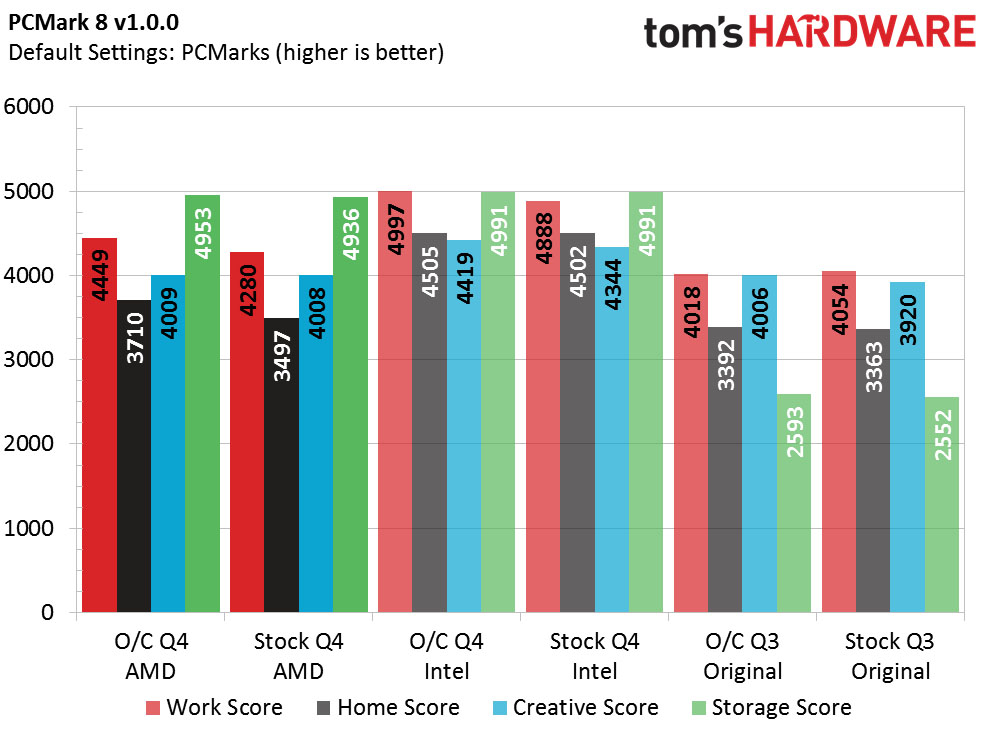
The new AMD build ties the Intel system in terms of 3DMark graphics, but falls a little short in the physics and combined scores. The tied storage score in PCMark is expected since they both use the exact same SSD, but everywhere else the new AMD build falls behind. It thoroughly beats the Original in every facet, however.
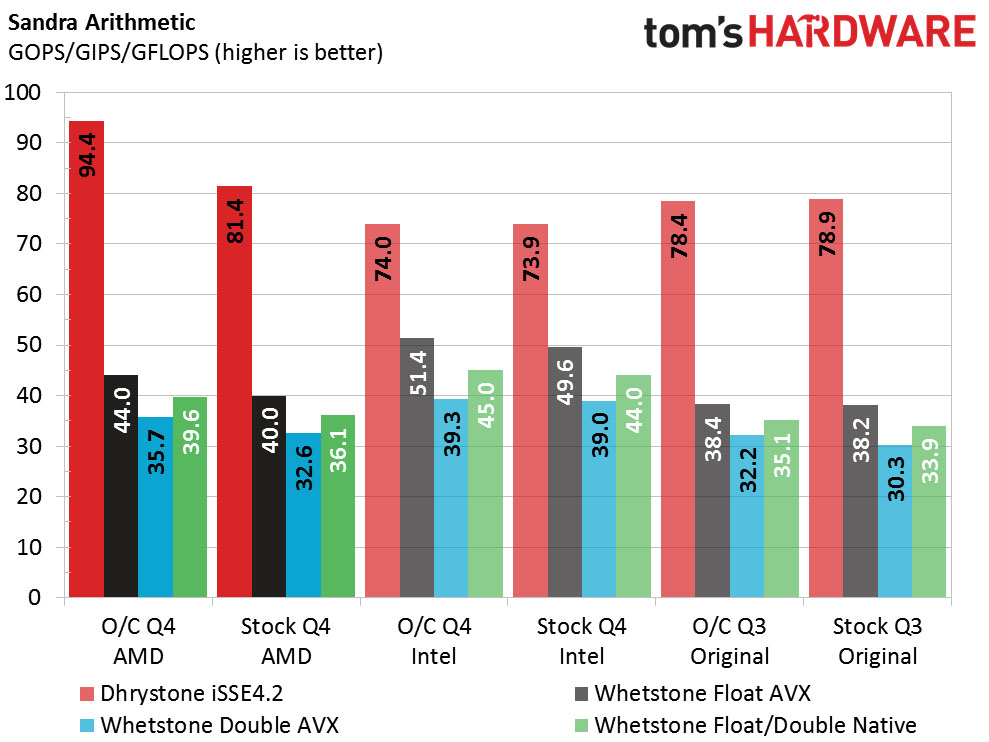
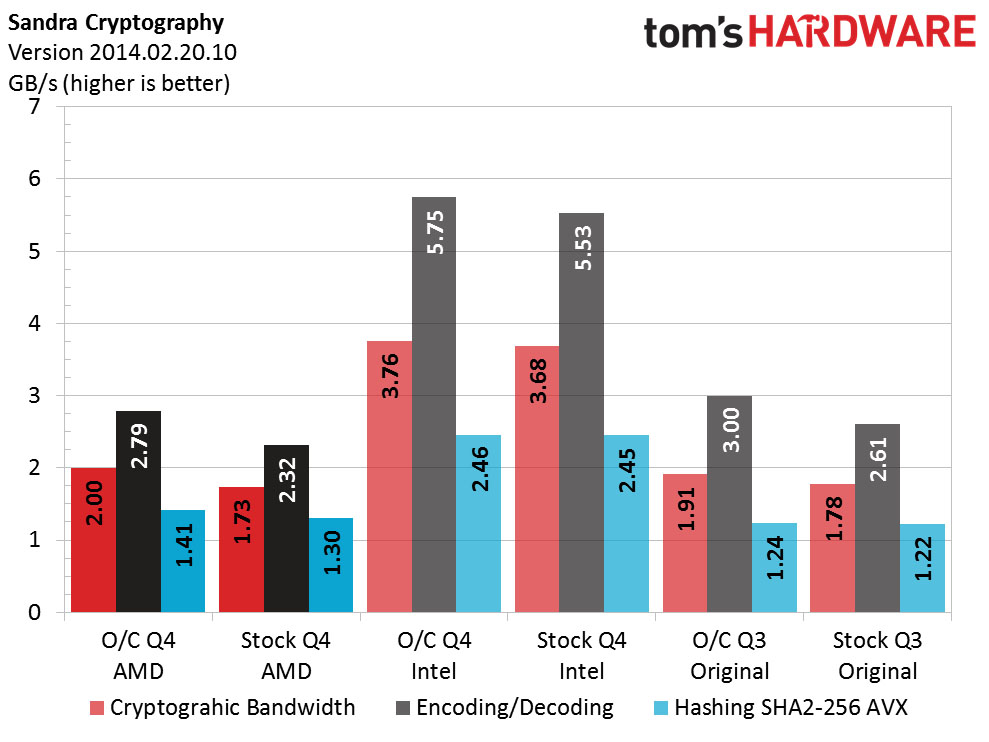
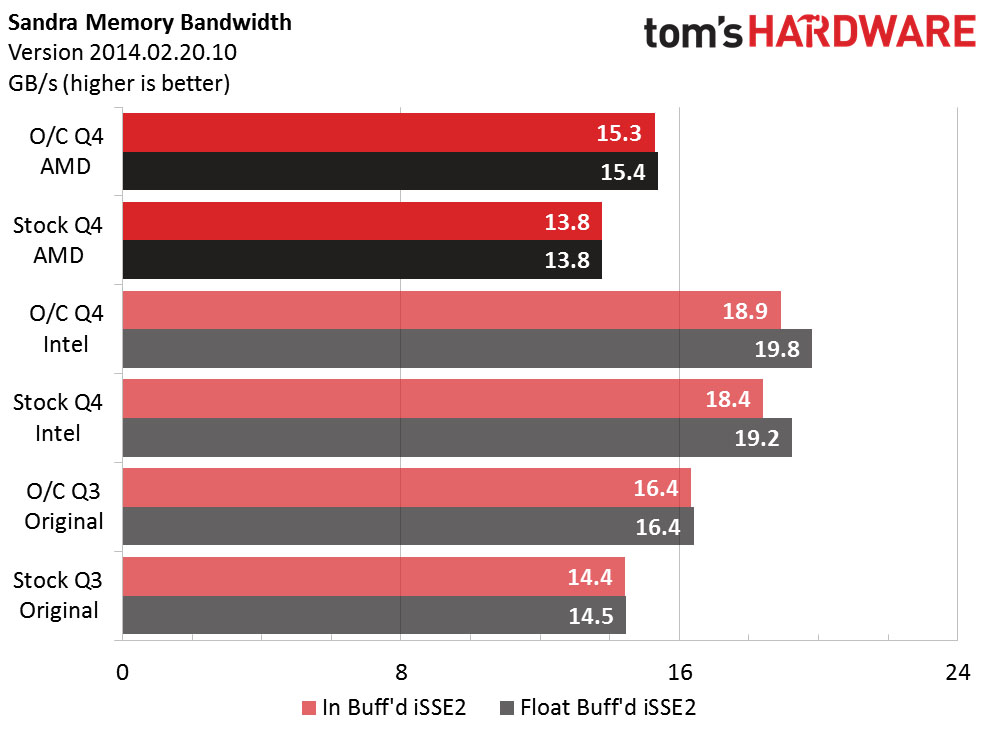
The improved cooling makes its first mark as the 860K extends its lead significantly in the Dhrystone section. But though the new AMD improves over the Original's score yet again, it still can't catch the i3 in the rest of the Sandra suite. The original retains an advantage over the new AMD in the crypto department thanks to its stronger memory bandwidth abilities.
Gaming
We see some interesting things in the gaming section as the new AMD actually loses to the Original in more than a few places. While a few FPS one way or the other can simply come down to variations in GPU temp at the time, these are consistent losses for the new AMD across many games. My best guess of culprit is memory bandwidth again. There's also a trend of the new AMD trailing the Original at 4800x900, particularly at the lower detail settings. I'm not sure what's causing this either, as 5760x1080 results are more in line with what we expect.
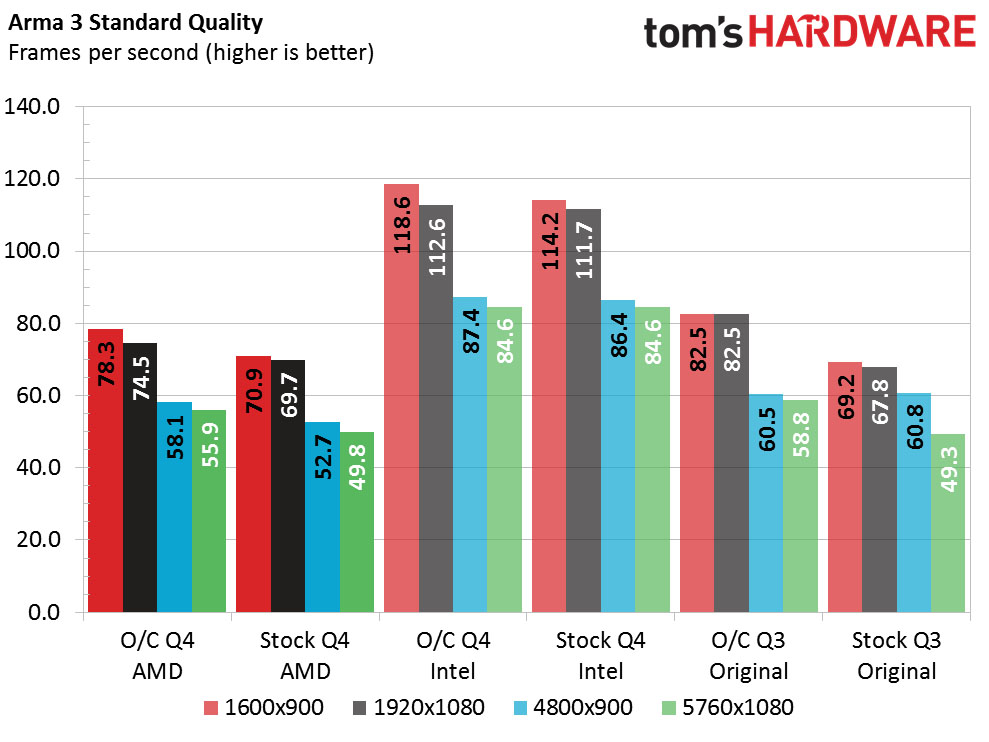

The new AMD build experienced some crashes with the DDR3-2133 settings and had to be run at 1866 for the Arma runs. This hit me as odd since 2133 was perfectly stable for four hours of Prime95 and 3DS Max renderings. As I do the gaming benches last, I didn't have time to redo the whole suite at 1866 settings. As it is, the new AMD loses just slightly to the Original, though most results are a tie. Arma certainly favors Intel's microarchitecture.
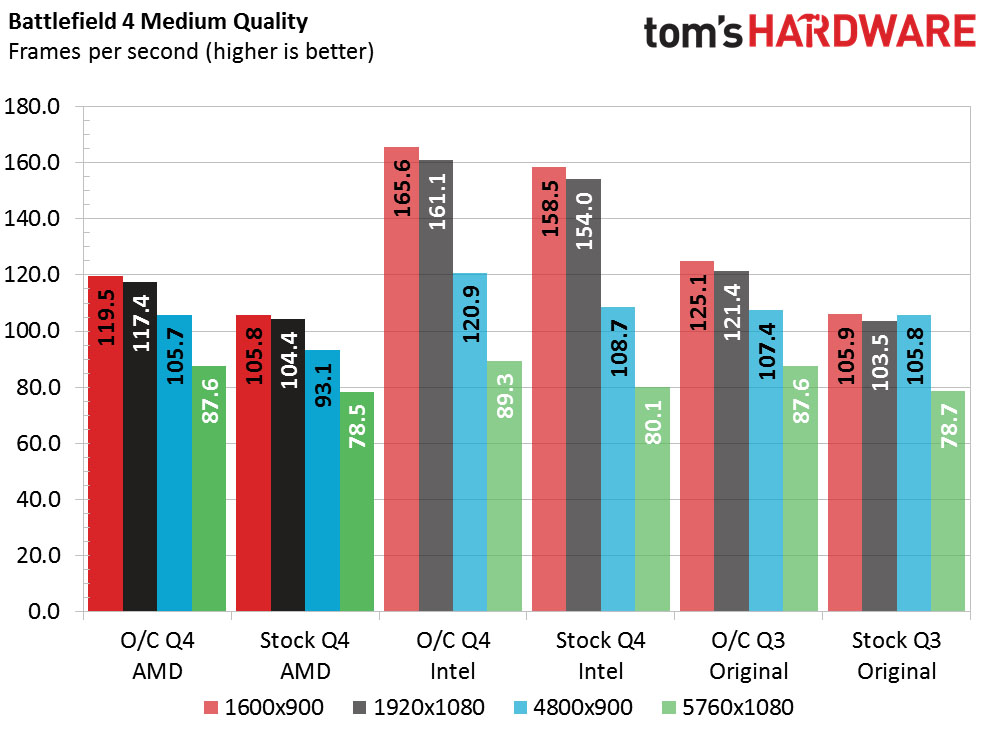
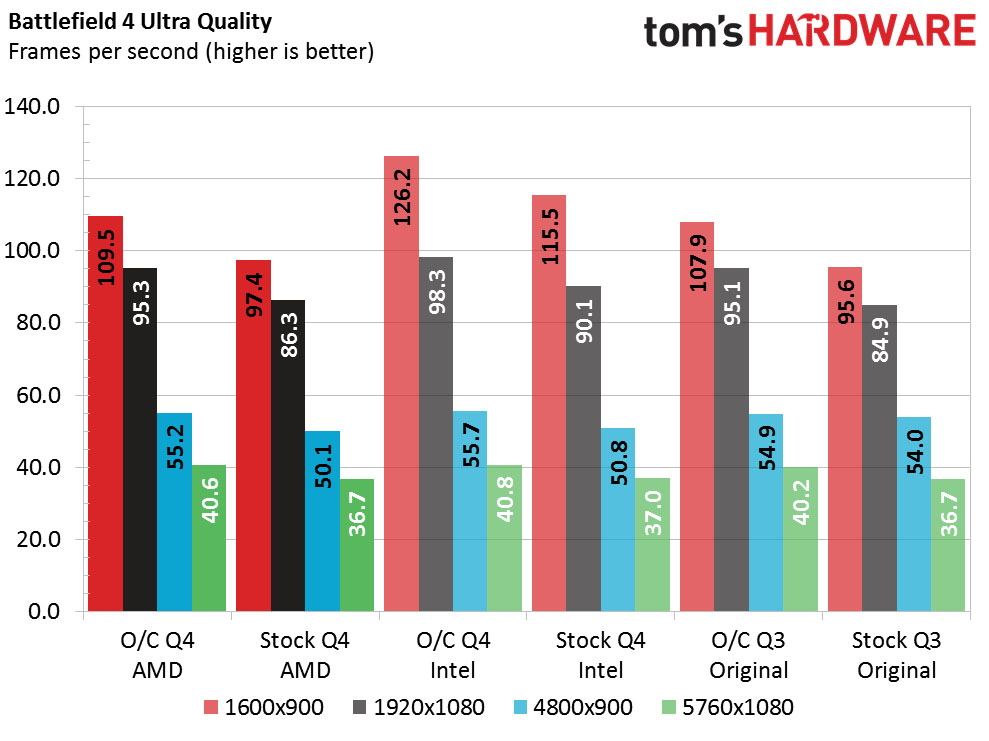
If you thought the Battlefield 4 results were similar a few days ago, they become almost identical here. The Intel build has a lead at lower details and most resolutions, but once you hit 1080p and Ultra details, you can't tell one machine apart from the next when playing.

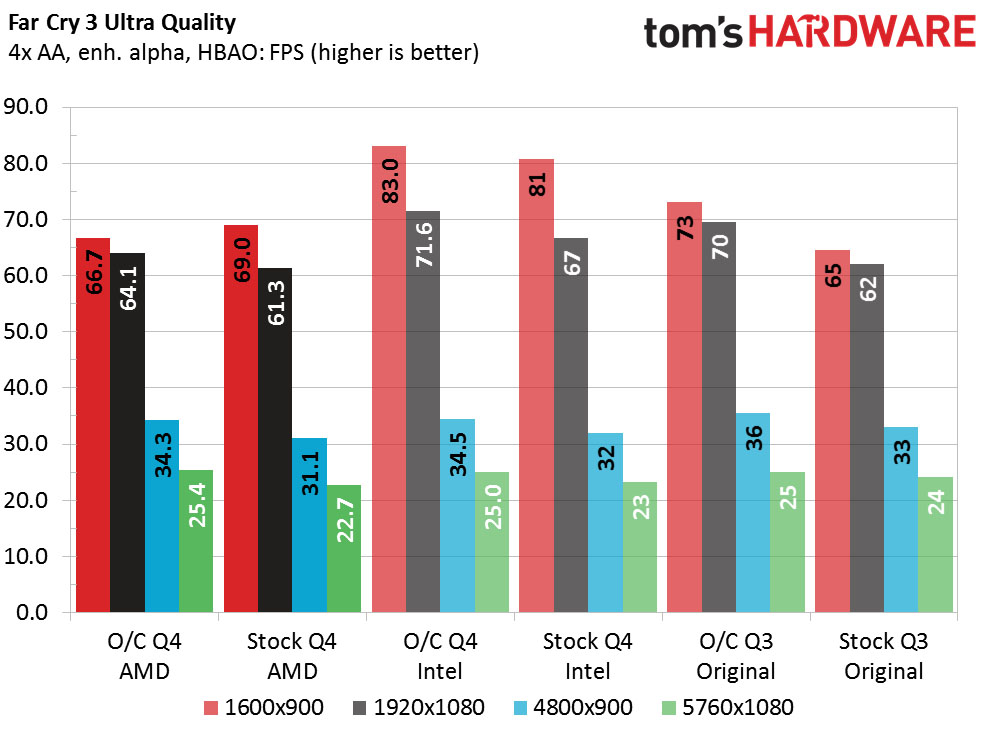
The new AMD build is actually penalized when overclocked in Far Cry 3. My best guess is the sketchy memory behavior that the motherboard exhibited in many other places. It's more apparent at lower detail settings. Cranking it up to ultra levels things out a little more, though the new AMD still trails by a small margin; the i3 is still clearly in the lead.
Get Tom's Hardware's best news and in-depth reviews, straight to your inbox.
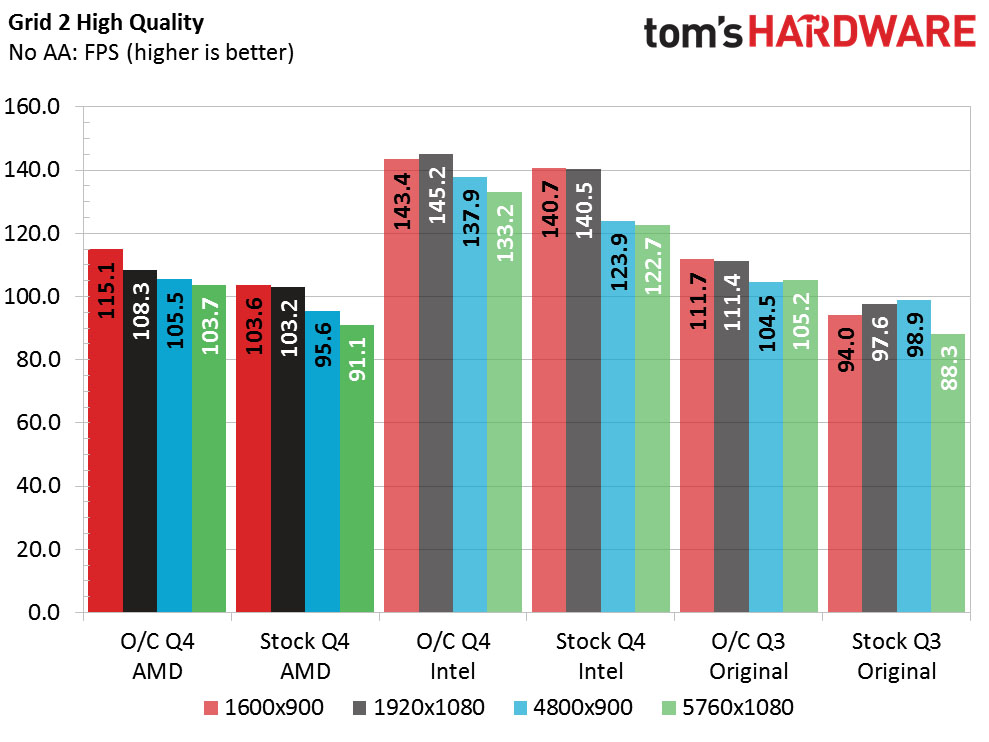

At stock clocks, the AMD rig shows clear benefit over the Original in Grid. This lead becomes even larger when playing across three displays. Neither AMD build can come close to the Intel version, though.
Applications
The new AMD build just got soundly thrashed in the last benchmarks. Is there any hope for it? Absolutely. Just check out the improvements in the real-world application benchmarks.
Even overclocked, the 860K can't match the i3 in efficiency for the single-threaded iTunes and Lame benchmarks. But let it bring all four cores to bear and you can see some magic. At the stock 4.0GHz turbo, the 860K is already beating the i3. Boost those cores to 4.3GHz and it takes a 30 second lead. Shaving seven seconds off the TotalCode benchmark is impressive, too.
The new AMD splits the Adobe suite with victories in Photoshop and Premiere. After Effects loves memory, and Photoshop with OpenCL loves Intel's efficiency, so the new AMD can't keep up there.
Once again, the new AMD splits the wins in the productivity group by taking ABBYY and an impressive win in 3DS Max. Cutting two minutes off the Original's score is impressive. It loses a close match in Blender, but Acrobat, as a single-threaded test, is far out of reach.
Though the new AMD build makes up a lot of ground in the compression suite, the i3 retains its crown.
While the 860K didn't win quite half of the benches here, it looks a lot more impressive than you would be led to believe going just by the game and synthetic tests alone.
Power & Temperature
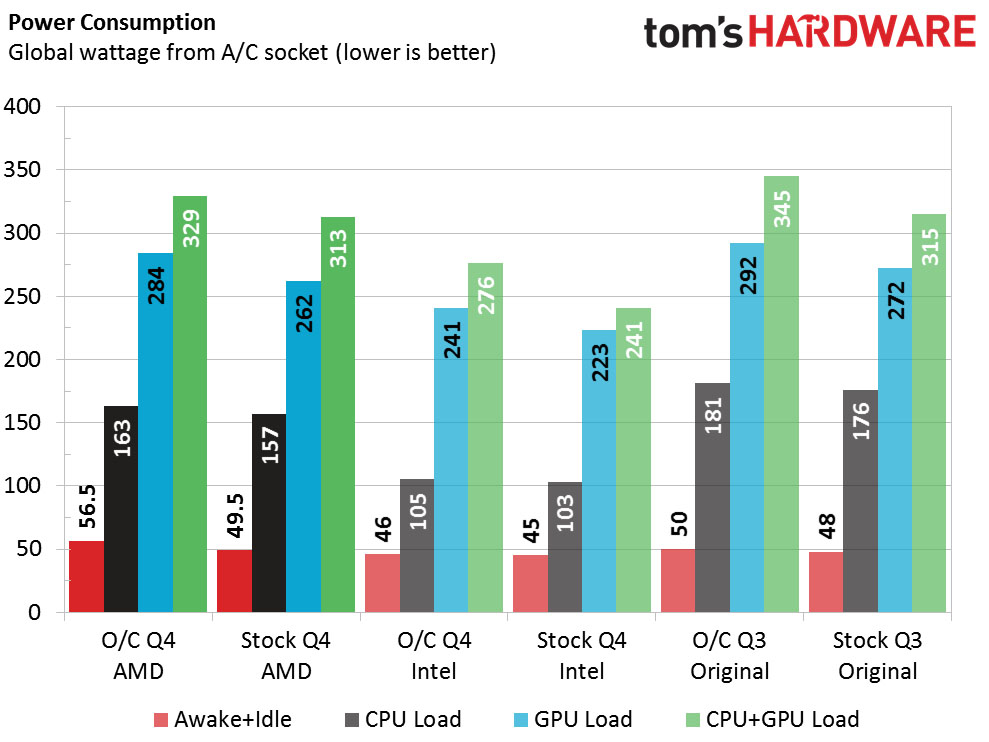

We always knew the AMD wouldn't have a chance beating Intel in power draw tests. However, I was able to cut more than 20W off the CPU usage while boosting sustained clockrates. Take the wins where you can find them, right? As for the strange CPU idle temps, I blame Gigabyte for that. Gigabyte's monitoring software said my CPU was idling below ambient. Chris reported his Gigabyte motherboard was saying the same. Thomas pointed out that since most thermal diodes read backwards from critical temps, the colder they are, the more room for error.
Overall Performance & Efficiency
With the stock Intel build set as the baseline, we can see clearly how the new AMD stacks up. While it scores a small victory in the Productivity category, everywhere else it falls well short of the Intel build. It's even a few percentage points behind the Original in gaming.
Once again, we know the AMD runs on a lot more power. There's no way it can win an efficiency award. However, it is 12 percent more efficient than the Original.
System Value
I'm using adjusted prices for what these components would've cost last quarter, the same I did earlier this week. While I only paid $912 for the whole system right now, it would've cost $946 and change three months ago.

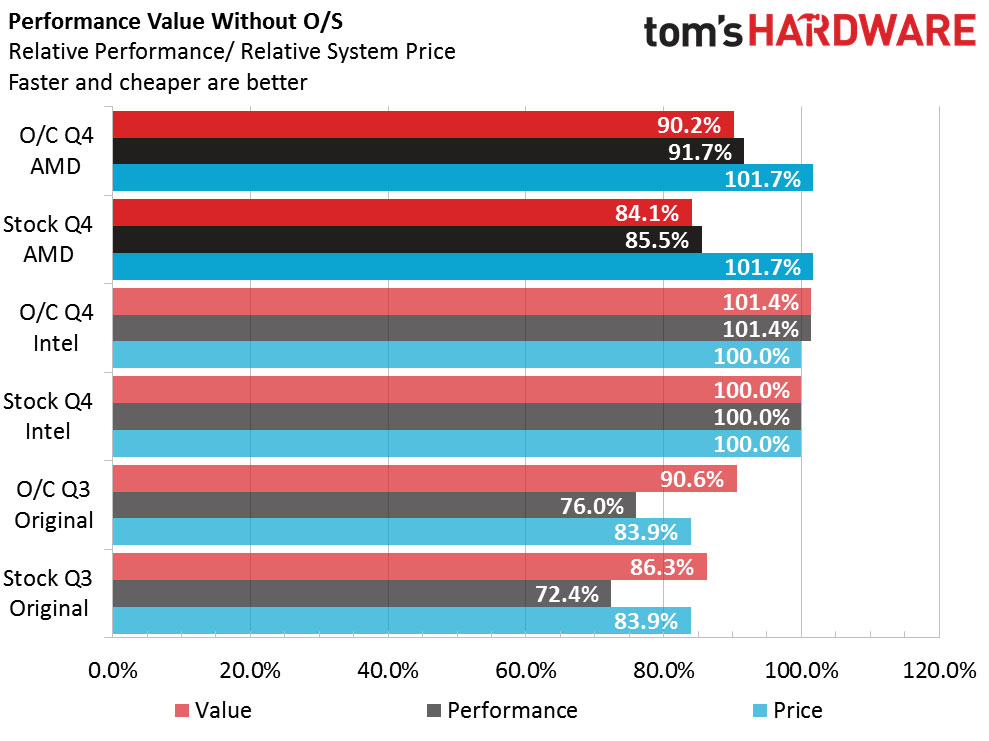
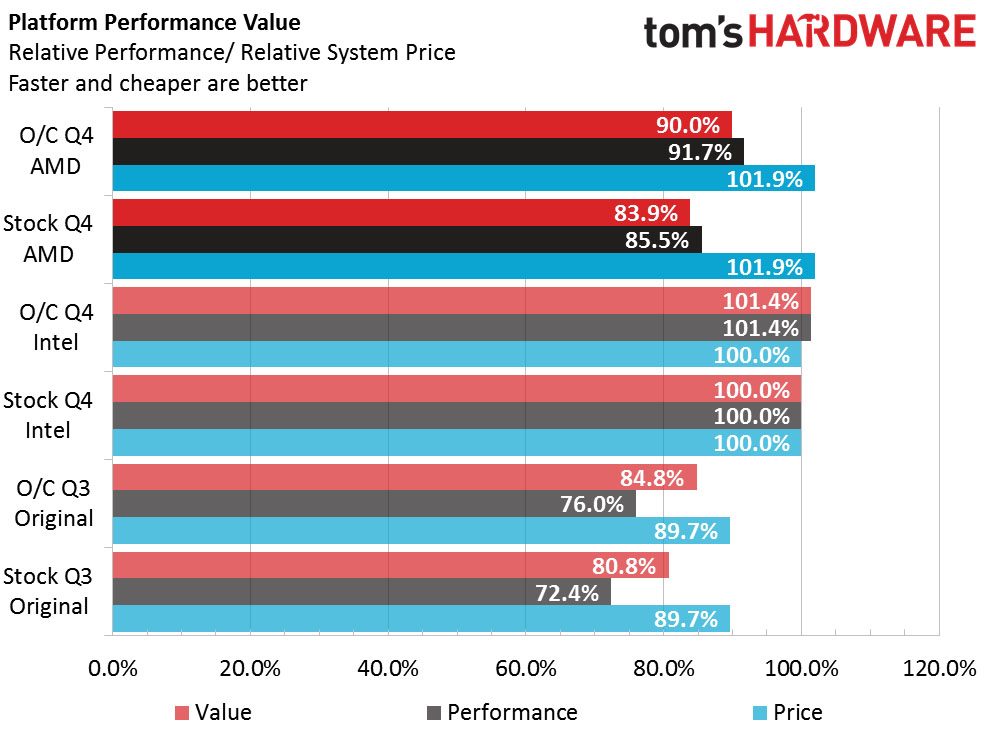
The final verdict is that no, the new AMD does not bring as much performance value to the table as the Intel build. Though it makes a nice six percent value jump from stock to overclocked, it's still 10 percent behind the Intel. While the Original seems to overtake the new AMD in value when you don't count the OS cost, remember that doesn't count the 1TB storage drive. Stripping it down to just the platform parts shows a better picture of actual user experience and value.
Gaming Value
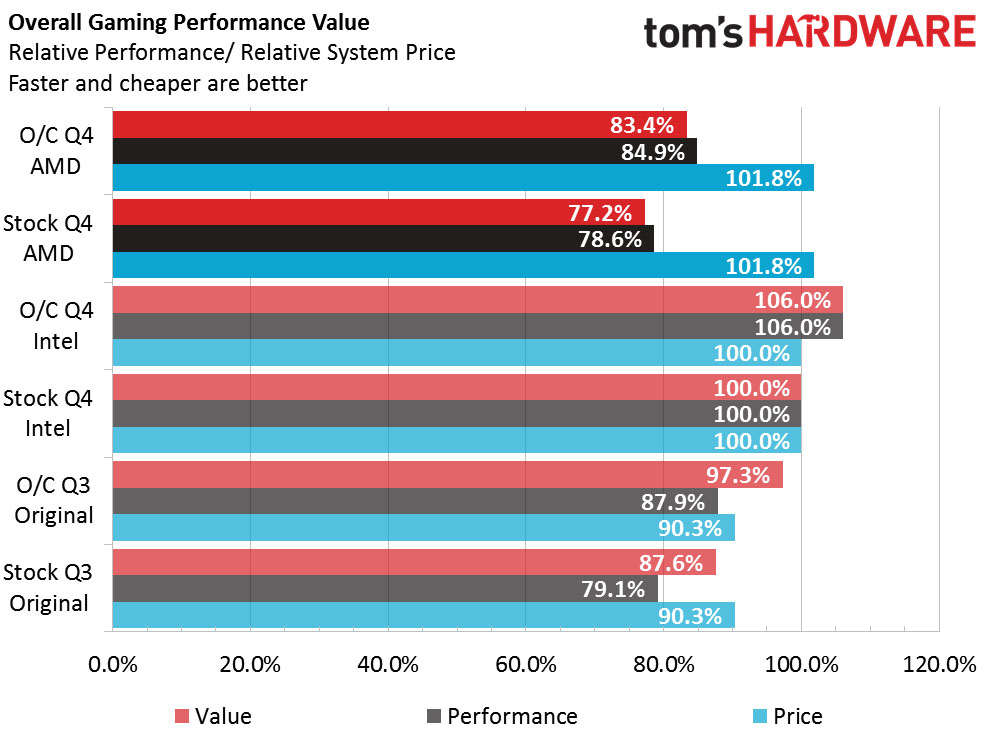


I'm almost sad to bring this up, but each Munchkin was meant to be a gaming build, and that means the new AMD has to take its medicine. Often scoring below the Original while costing more severely hurts the new AMD's value.
Final Thoughts
So how do I rate this new AMD build? Mixed. This third revision has been a sick cycle carousel that's seen both desk pounding cries of agony and adulation. It's supposed to be a gaming machine, but it usually performed worse than the last two iterations. That looks bad, and is a black eye for me. Hey, I'll take my licks. The bright spot here is the huge improvement in productivity and professional applications. When not outright winning, the 860K was usually close behind the i3. I wasn't sure it would win more than a handful of benchmarks, but it came close to taking half of them. But I have to temper my excitement about that because overall it was only one percent better — that's almost margin of error level. Perhaps with a better motherboard I wouldn't have been hit by the memory performance glitches.
But that comes to the heart of the matter: the uncertainty of overclocking. Can an 860K be overclocked to the point that it beats an i3? Yes it can. But that comes with a lot of caveats. First, you need a chip that's capable of hitting at least 4.3GHz (preferably 4.4GHz). That's not a given. Second, you need a good motherboard that can not only get the CPU up to those clocks, but that can get your RAM to DDR3-2400 speeds (or better) in order to match the bandwidth that the i3 gets at DDR3-1600. And unless you want to spend more money on less performance, you need to find all this, as well as a good CPU cooler, for about $200. It's certainly not impossible, but it's definitely not simple.
I understand the tinkering mentality. Until you know how to take something apart and put it back together better than it was, you don't feel like you have fully mastered something. We love tweaking our computers and squeezing every last drop of performance out of them. That's all we want. No more, no less. But at what point are we just wasting time?
While you can tweak an 860K to approach the performance of an i3, how much extra time and effort does it take? Not only in tracking down the exact parts you need, but also the time, effort and frustration of finding the optimum overclock settings. In the end, you only get single-digit performance gains. Can you put a money value on your time? If so, factor that into your performance value calculations.
I don't mean to discourage anyone here. If you want to push your FM2 platform to the limit, more power to you. And please, share your success stories in the comments. I love reading them. I'm just not the type of person that enjoys masochistic puzzles.
Eric Vander Linden is a Contributing Writer for Tom's Hardware. Follow him on Twitter.
-
RedJaron After this latest build, I think I'm AMD'd and ITX'd out for a bit. Next quarter it's time to build a nice, simple machine.Reply -
Joe Black I get that a small form factor lan box is desirable, but the option existed to put together a build on a more traditional form factor and include an FX 8-core processor like the 8350 for only $10 more than the i3. Tom's own charts show that they are decent performers and personally I'd be happy to forego the small box for a better processor.Reply
Edit: Note that I referred to this pricing: http://shop.amd.com/en-us/components/processors/FD8350FRHKBOX#
Not sure how accurate it is. -
Onus Is the 860K a viable chip? Sure it is. AMD fanboys need to sit down and take their licks though, because in performance, power usage, and build/tweak time, the game is up; a non-"experimenter" should now always choose Intel. I hope Zen makes a difference, but remember people (including myself) had high hopes for Bulldozer too, and we know how that turned out.Reply
Solid data point!
-
chesteracorgi Using yesterday's i3 is a cheat against Intel. I just built an i3 6100 for my Grandson, and it rips up the Sandybridge 2500K in gaming. The build:Reply
Corsair Carbide Spec 1 case (with an extra 120mm fan.
Intel i3 6100
ARRock Z170 Gaming K4
CoolerMaster Hyper T2 cooler
LG DVD reader/writer
Samsung 850 EVO 250GB
GSkill DDR4 3200 Ripjaws 2X 4 GB
PowerColor R9 380 4GB RAM
Corsair RM 750W PSU
CM Storm Devastator KB & Mouse
ASUS 23.6 in monitor (2ms gtg)
At a little over $800 I'll put it up against your $1000 and $1100 builds in gaming.
-
filippi +1 chesteracorgi. We prob will see some i3-6100@4.4GHz / i5-6400@4.5GHz paired with the newegg $80 ASRock Z170 Pro4S next SBM :DReply -
James Mason What if on the next SBM, you guys each start with 1 of the 3 goals, choose/make your build, and then pass it to one of the others, to make any refinements they see to it, and then pass it a 3rd time again for further refinements, to achieve "peer reviewed" build to see how instead of competing but actually kind of working together to all make the best you can while being able to take in ideas the original builder may not have though of.Reply -
RedJaron Reply
I'm not sure what point you're trying to make. We can only use prices of parts purchased from Newegg ( SBM rules ) and for this particular quarter, it would have to be purchased the last two weeks of November.17230114 said:At a little over $800 I'll put it up against your $1000 and $1100 builds in gaming.
James, if we did something like that, it would be nine months of SBM with the same computers only undergoing minor revisions. It's unlikely they would take into account all the newly released parts throughout the year. I think people would get bored with it.
Filippi, I wouldn't rule out i3 OCing next quarter, but I don't think I'll go for it. I don't want to bother with the OCing lottery in hopes to win the value award for a while. I'm thinking a nice Xeon E3 is in my future, depending on the next theme. -
James Mason Reply17231280 said:
I'm not sure what point you're trying to make. We can only use prices of parts purchased from Newegg ( SBM rules ) and for this particular quarter, it would have to be purchased the last two weeks of November.17230114 said:At a little over $800 I'll put it up against your $1000 and $1100 builds in gaming.
James, if we did something like that, it would be nine months of SBM with the same computers only undergoing minor revisions. It's unlikely they would take into account all the newly released parts throughout the year. I think people would get bored with it.
Filippi, I wouldn't rule out i3 OCing next quarter, but I don't think I'll go for it. I don't want to bother with the OCing lottery in hopes to win the value award for a while. I'm thinking a nice Xeon E3 is in my future, depending on the next theme.
No I meant for 1 single SBM round, working collaboratively, like maybe "before it's built." -
Calculatron What is up with the high stock voltages on the 860K? When I was thinking of getting one for my secondary test rig, I noted the insane voltages people used both at stock frequencies, and overclocked. I ended up getting a 760K instead, but only because I bought it from a friend who was parting out a rig.Reply
I have that 760K clocked at 4.4ghz with ~1.33 volts, if I remember correctly. It is seated in a Gigabyte FMA88X-UP4, paired with G.skill 2400 DDR3.
With 1.45 volts, I can run it at 4.8ghz and still remain below that throttling threshold. Going beyond requires some serious cooling. (Using a Thermalright Archon SB-E X2.)


